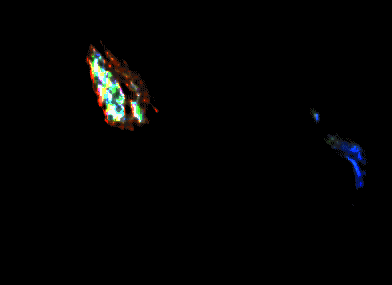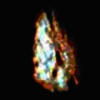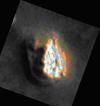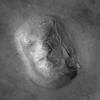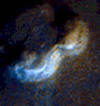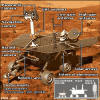|
|
|
from EnterpriseMission Website
For, after almost 30 years of acrid controversy and
debate, a "whole new side" to this perplexing Martian mystery - and the
profound social and scientific questions it continues to present - has now
literally dawned ….
The five frames -
from the near "IR" end of the visible spectrum, to the "violet"
- were
acquired by the Odyssey spacecraft as it flew over the Cydonia region on
October 24, 2002 - precisely one year (Greenwich time) after Odyssey
arrived in Martian orbit.
What this unique sun angle has now revealed - a Cydonia view that researchers had yearned for, but never before had the opportunity to analyze - is nothing less than revolutionary ….
For, even casual examination of the Face as seen in this "new light" (right and left) reveals two new pieces of vital information: Even those of us who, for some time now, have interpreted the weight of evidence in favor of an artificial origin for this unique Cydonia construct, this new data is unexpected - nay, startling - confirmation of our previous analysis.
The key parameter that makes this new image so remarkable, is "when" it was acquired.
If you carefully examine the "data block" for image V0 3814003 on the Arizona State University (ASU) THEMIS website (right), you can immediately ascertain that it was taken by the Odyssey camera "at 4:39 AM," local Martian time.
Further reading of the table reveals that the "phase angle" - that is, the geometric relationship between the Sun, the Martian surface directly underneath the spacecraft just east of the Face, and Odyssey itself - was "90.3 degrees."
Since "90 degrees" (for a spacecraft directly overhead)
would indicate the Sun was literally on the eastern horizon, the slightly
greater angle reveals that actually the sun was 0.3 degrees below the
horizon when the image was acquired (and even slightly lower at the location
of Face itself).
This simple, inarguable geometry makes the astonishing high brightness of
the Face's eastern side - and before the Sun has risen - extraordinary ….
And this, in turn, leads directly to the pivotal question: just what could
make "an average Martian mesa" (to quote
Carl Sagan, from his infamous
Parade Magazine "Cydonia hit piece" many years ago) so incredibly reflective
… even in the semi-dark, pre-dawn twilight of
Cydonia?
A side-by-side comparison (right) reveals the true incongruity of such a brilliant-surfaced object.
The official NASA version of the Face from V03814003 (right/left) is totally "washed out" on the illuminated (eastern side) - even though the image was shot before the sun had risen!; while, in the Enterprise rendition (right/right), after considerable effort to lower brightness levels, some surface details can just be seen beneath the glare.
To learn just how "anomalous," one only need look to spacecraft surface images of pre-dawn Martian twilight, captured by other unmanned missions … for instance, the unmanned Viking Landers in 1976 (left) or Pathfinder, in 1997.
The bluish "afterglow" several degrees
above the sunset point on Mars is due to the unique "forward scattering"
properties of the much thinner Martian atmosphere, which is filled with
varying amounts of finely-divided dust (in the official model) -
preferentially scattering blue light forward toward the camera ….
And why is that inexplicably reflective eastern surface also arrayed in those stark … startlingly geometric … patterns?
But it's a Viking 2 sunrise shot that best illustrates this major new Cydonia mystery.
With the gamma of the same image significantly increased (below-left) -
equivalent to the gain employed in the Odyssey VIS camera for the pre-dawn
Cydonia image - the surface rocks and other features become more visible.
But, as is readily apparent, with the exception of two small foreground objects at the lower right, brightness extremes presented by the Face are simply not present on the reddish rocks and boulders strewn across this Martian landscape - even when directly illuminated by the rising sun!
The exceptions (right) are in themselves most interesting.
The problem with applying this natural explanation to the Face is simply this:
For the inevitable critics of the preceding image processing and Face analyses, it is imperative for everyone to realize that these spectacular results have been achieved by merely decreasing the brightness of Odyssey image V03814003, and then applying a 3X pixel over sampling (to smooth out "jaggies").
No other "image processing" techniques have been applied.
As can be seen, by the time the brightness has been decreased
to approximately 10% of the official published image value, the astonishing
3-D geometry of the Face's eastern side (left) is easily and overwhelmingly
apparent.
If we equate the surface brightness of the soils around the Face with NASA's published estimates of the average albedo (reflectivity) of the Cydonia region (about 20 percent - according to a pre-Pathfinder NASA Conference), we can then approximate the relative reflectivity of the Face in this new image, based on when the surface "disappears" in our brightness reduction animation (below - press keyboard F5).
Keeping firmly in mind that these are only "ballpark estimates," the Face via this technique turns out to be reflecting - straight up - an amazing 99.9% of the surface illumination falling on it, compared to the ground's average of about 20%!
Since no rocky surface can possibly have this degree
of right-angle, natural reflectivity - the Face's eastern side MUST BE
acting like a set of coherent, artificial mirrors!
Further, the multi-colored, "prismatic" appearance of these striking 3-D "panels" (close-up-left) raises the serious possibility of semi-transparent, glass-like refractions in this material - from whatever is making up this structure. This, in addition to the previously discussed, front surface, mirror-like reflections ….
This, in turn, is totally
consistent with the possibility of a highly anomalous artificial surface to the Face's construction … which we published over ten years ago.
And, when an elaborate effort is made to equalize the much darker, western half of the structure with the brilliant eastern-side (right) - again, by only adjusting proper image brightness and contrast from east to west - the three-dimensional, internal scattering nature of the Face comes "shining through" … obviously, exactly as someone on the Odyssey team intended, and as we scientifically predicted over a decade ago.
Beginning in the 1992 Edition of "The Monuments of Mars," we strongly suggested that the Face was NOT merely "a mesa-carved 'Mount Rushmore'… lying on a level Martian plain" - but something "far more interesting."
The bright "Face highlight" of the non-fractal Face image
indicates how much it departs from its far more fractal surroundings
….
Here's what we said in1992: that Carlotto's newly published "non-fractal
Face results" were likely due to a "sophisticated placement of
shadow-casting [artificial] pyramidal substructures on [the] underlying mesa
.… "
This was in direct opposition to the prevailing opinion of all other researchers at the time (those who took seriously the tenant that the Face is indeed "an artificial structure") - who believed (and still do!) that the Face was carved … in other words, "Mt. Rushmore."
In my opinion, to the contrary: Carlotto's provocative fractal results
strongly indicate that the Face (or at least large portions of it …) has
been built.
Remarkably, the latest multi-spectral Odyssey "dawn" Cydonia image - V03814003 - now further supports precisely such a model.
By revealing an inexplicable, "honeycomb-like" pattern on the Face -
visible as a series of "brilliantly reflective, geometric patches"… but only
on the eastern side.
Further, this new pre-dawn data
totally eliminates several competing hypotheses put forward in 2001 to
"explain" the striking visual asymmetry when the MGS "full Face image" was
first released - including, those that speculated that "deep sand dunes"
were covering the eastern aspects of the Monument!
As can be seen, "something" about that eastern surface is creating an intensely mirror-like reflection of the pre-dawn Martian lighting - and in a distinctly geometric pattern.
Could this merely be some type of inherently bright "scattering" material … like snow?
That "snow" is not a likely explanation for this striking optical appearance, can be seen by in this crucial terrestrial comparison (left).
The object on the left is "Shiprock Butte," a literal sunrise shot of an awesome, wind-eroded surface feature in northwestern New Mexico, considered an analog in the "mainstream" view to the "wind-sculpted natural geology of the Face on Mars."
The object on the right is the new Odyssey "pre-dawn" composite image of the Face - its brilliant eastern side (again, in the dim pre-dawn Martian lighting), clearly overexposed.
Note that Shiprock has some snow on it, both on the sunward facing side and
in the shadows. However, even under direct sunrise illumination here on
Earth (1.5 times closer to the Sun, thus 2.25 times brighter), the light
scattering from the Shiprock snowy surface
(above/left-left) cannot begin to match Odyssey's pre-dawn reflections from the Face (above/left-right)!
And, if "snow" was present on the
Face when the image was acquired (hardly likely, given the official Martian
northern hemisphere date of image acquisition - northern summer), why didn't
this same snow fall on the shadowed side in the Odyssey view … or on the
other, nearby mesas … as it has at Shiprock?
In other words, the evidence just presented strongly indicates that "something" about the protected eastern Face's surface (the "feline" half …) - captured by Odyssey in an instant of precise pre-dawn sun/spacecraft illumination geometry - is capable of producing mirror-like reflections … bounced 250 miles straight up … even before the sun had risen over the Cydonia horizon!
As can be seen, while the Face's eastern flank again is totally overexposed in the Odyssey view, the mesa right next door is barely lit! Yet, the source of illumination for both objects is exactly the same… the pre-dawn brightening several degrees above the Cydonia horizon.
Then, note hints of a similar rectilinear structure on the Face's surface in the white light image, at opposite lighting and higher resolution.
This key similarity - but at two totally different scales - suggests that the brilliant reflecting elements seen in the Odyssey, 20-meter color version may in fact be larger scale, more massive interior structures - captured underneath the visible light features seen in the MGS 5-meter view.
This would have been possible because of the unique illumination angle of
this image…pre-dawn sunlight, shining almost horizontally through a
high-tech, now porous (glass?), still eroding eastern surface covering
- to
be photographed by Odyssey, looking straight down at a 90-degreen angle. A
good analogy would be the view through a fine-mesh window screen at
twilight, into a well-lit room - where the mesh is literally too small to
be seen against the massive illuminated pieces in the room ….
Kynthia, the Enterprise art director for many years, has spent considerable time and effort painstakingly sculpting (in clay - remember that?!), as well as with computer-generated models, what the eastern "feline" side should look like … when we finally had Odyssey's new view.
Above is a direct comparison.
Back to the surroundings of the Face
Again, take that "average mesa" to the southeast of the Face (immediate right, right). In this darkened, more realistic rendition of a portion of image V03814003, it is now evident that it too is not behaving exactly like "an average Martian mesa."
First of all, its dramatic brightness difference, compared to the Face's "right next door," is NOT because of any major differences in height.
As can be seen again in the Mars Pathfinder post-sunset imagery (left), after sunset (or before sunrise), the primary landscape lighting comes from a large area of the sky - several degrees above the point where the sun has actually set (or will rise).
Thus, the sky illumination of both features in
V03814003 - regardless of their intrinsic height - is essentially the same.
So, how to account for their dramatic differences in brightness … if not
color … in image V03814003?
The unmistakable "bluish" tints on the southeast (facing the pre-dawn sky) are a further signature of internal scattering of the predominant color of the pre-dawn sky itself...
The only known material that is a) transparent, and b) can create such
prismatic coloration, as well as "a bluish, scattering of sky light" … is
glass - a most unlikely substance, I think you would agree, to be found on
"a naturally eroded mesa at Cydonia...."
There is also, in this un-rotated, lightened version of the same feature
(left), a remarkable array of additional, also distinctly "bluish"
geometric patterns evident all across the entire upper surface… some even
arranged in precise, concentric circles.
These patterns clearly outline the formerly highly symmetric nature of this construct! For example, a "straight line axis" - connecting two of these "concentric circles" at each end - dominates the overall morphology.
This
axis is at a 45-degree angle to the image frame and, significantly, is also
precisely parallel to the Platform edges of the Face, just northwest...
This stunning object - seen literally in this new light - is also clearly
NOT "just another average mesa!"
As a stunning set of "right-angle glowing features and internal rectilinear geometries," apparently created by a massive array of partially surviving shattered glass cubes! These incredibly geometric features, as can be seen (right), are scattering the blue sky light even more intensely… before another Cydonia dawn …
Discovered on the original 1976 Viking images, this singular five-sided feature (left), located just a few miles southwest of the Face, has come to represent - perhaps even more than the celebrated "Face" itself - the continuing, haunting enigma of Cydonia ….
Properly termed the "mathematical Rosetta Stone," because of its unique and telling internal mathematical relationships, the physical nature of this object remains a major Martian mystery.
But, mysteriously, even though the Mars Surveyor spacecraft has been in orbit for over six years, Michael Malin (Principal Investigator of the MOC camera aboard the MGS) has yet to release a full-on, high-resolution (>5meters) image of this extraordinary, obviously highly symmetrical Cydonia structure.
Without such detailed close-ups, fundamental questions regarding
the true nature of this object will remain unanswered ….
Perhaps even more important, whereas all previous D&M images (Viking and Odyssey) have been taken with the sun coming from the left, in this image the Pyramid is clearly illuminated from the right - the direction of the not-yet-risen-sun.
It is immediately apparent in this image that the D&M - named by the author
after the two original Goddard contract imaging specialists who found it on
the Viking imagery, Vince DiPietro and Greg Molenaar - is as reflective at
this viewing angle as the Face itself! Significantly, the "mesa in the middle" (left), is scattering just about what would be expected in this lighting, while the Face (top) and D&M (left, left) are distinctly far too bright...
Again, differences in height or surface slopes should make no difference here … as the source of illumination is a large, diffuse area in the Martian eastern sky many degrees above the Cydonia horizon (see again, Viking and Pathfinder surface images, above).
Clearly, whatever material is making the Face
literally "glow" in this pre-dawn light, is also having the same effect upon
the mysterious "D&M"…
And, in this comparison (below, far right),
Again, this new view now provides startling confirmation of a hypothesis
initially framed in the first edition of "Monuments," now almost 20 years
ago: namely, that the D&M is literally hollow - created as a vast,
compartmentalized "super condominium" … a true "arcology" on Mars. The
ordered geometry - together with the anomalous reflectivity - seen here, only reinforce that original view ….
One can only wonder what a similar pre-dawn image, secured by
Odyssey… in color… would reveal about my other original discovery…
The
City of Pyramids itself.
By virtue of their onboard color CCD stereo cameras,
and the sophisticated analytical x-ray and gamma ray equipment that they
carry, we'd then know in short order if these anomalous optical features
seen from orbit are backed up by true physical anomalies measured on the
ground … including, the unmistakable signatures of manufactured, high-tech
ruins….
But, NASA is not the only "player" in the game this time."
Since two of them - the Japanese "Nozomi" mission, and Europe's "Mars Express" - are NOT being operated under NASA management, there's at least a glimmer of hope (ironic - since that's what "Nozomi" means in Japanese - Hope!) that one of these three foreign spacecraft might actually, independently, add significant new information to the "artificial structures on Mars" question.
But - only if they secure some specifically targeted,
carefully timed new observations of previously known ruins - and then only
if they're "allowed" to make the information public…
Though the Japanese (Nozomi) mission will possess a three color CCD camera called MIC ("Mars Imaging Camera"), its capabilities are limited by the overall mission design - which constrains its latitude of coverage of Mars and pixel resolution… the latter to about 60 meters, and only at the equator.
Therefore, the ESA
"Mars Express" mission is probably our best shot.
For roughly 40 minutes each revolution, centered around periapsis (the spacecraft's closest point to Mars), the on-board HRSC (High Resolution Stereo Camera) system will take images - in color, stereo and at very high resolution … down to ~2-meters per pixel.
The rest of the orbit will be
devoted to relaying this imaging data back to Earth, and conducting other
on-board observations.
It is the stereo and color capability of the HSRC which interests us here
the most.
By timing it's flyover at the same pre-dawn geometry as the Odyssey image, and comparing the position, brightness, and color changes of the reflection features in its successive stereo HRSC scans, the physical location of the reflecting elements - either on the Face's surface, or underneath - can be firmly determined by the Mars Express mission.
In addition, examination of
the neighboring "mesas" - also in stereo and color - will allow
determination of their relative compositions and/or physical surface
differences, in comparison to the Face.
That's where you come in. If enough readers of this paper, and followers of this continuing Investigation, demand that the Principal Investigator of Mars Express' HRSC - Dr. Gerhard Neukum, of the Freie Universität Berlin - use the HRSC's exquisite stereo and color capability to secure this vital information … it can be made to happen.
How? Simply,
One last point:
The Aug. 15,2003 issue of Science, probably (next to Nature) the most
prestigious science journal in the world, ran an editorial entitled "One
Nuclear Leap To Mars." In it the editorial writer discussed the possibility
of finding "something bizarre on Mars that would trigger a manned Mars
expedition."
The last paragraph in particular is the most telling: the writer concludes by saying,
The last quote being from astrogeologist Jim Rice, of Arizona State University.
|

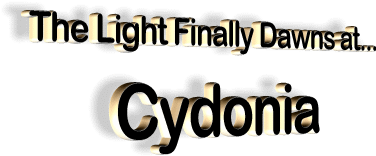

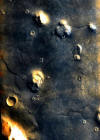


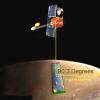



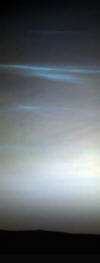


 It is apparent
that their bright sunward-facing surfaces are from polished, mirror-like
reflections - probably caused by wind blown sand abrading over time metallic
crystal surfaces (or, at least "something" metallic…).
It is apparent
that their bright sunward-facing surfaces are from polished, mirror-like
reflections - probably caused by wind blown sand abrading over time metallic
crystal surfaces (or, at least "something" metallic…).

